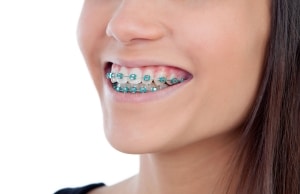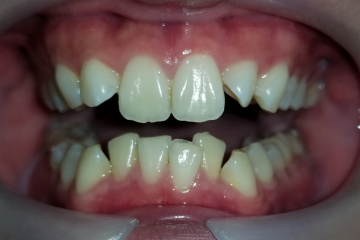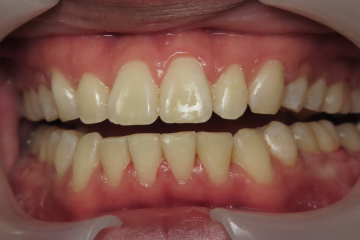Reveal a More Confident Smile with Braces in Hilliard, OH
Considering smile alignment for you or your child? If so, braces in Hilliard, OH may be the most ideal path to a more confident, functional set of teeth. At Fishinger Dental, we offer a full range of services when it comes to smile alignment, including different types of braces. Reach out to our office to schedule a consultation for yourself or your child if you suspect braces are needed.
Why Braces Are Often Recommended
Braces are recommended for a long list of smile alignment issues. Alignment issues can vary in severity and form. Some patients may have problems with only the positioning of the teeth, while others may have jaw alignment issues that also need to be addressed. Braces may be recommended to correct:
- Gaps and spaces between the teeth
- Crowding or overlapping of teeth
- A misaligned bite, such as crossbite, overbite, or underbite
- Jaw alignment problems
- Crooked, twisted, or oddly positioned teeth

How Braces Treat Smile Alignment Issues
In the most rudimentary terms, braces work by exerting pressure on the jaws and teeth to shift their positioning over time. With standard braces, pressure is applied by adjusting the tension on each bracket and wire. With Invisalign or other clear aligners, pressure is exerted by the aligner itself. As the teeth move into the desired position, the soft tissues that support and surround the teeth also change.
Over the course of treatment, the dentist will require ongoing appointments to check the progression of treatment and make adjustments as needed. Throughout treatment, dental hygiene is important and any issues with decay should be immediately addressed.
Getting Braces: What to Expect
The process can look a bit different depending on the patient and the type of braces used. For the most part, the process will involve:
- Initial consultation and evaluation to determine the alignment issues that need to be addressed and the best route of treatment
- An appointment to take impressions or scans of the teeth
- An appointment to either install the braces or pick up the first set of aligners
If you have traditional braces, the teeth will be cleaned thoroughly before the brackets are installed. The dentist will use a medical-grade adhesive to attach the brackets to the surface of each tooth. Wires are used to connect each bracket to the next, and a small tool will be used to apply pressure on certain teeth. During your initial appointments, the dentist will take the time to explain what to expect with treatment and how to properly care for your teeth during treatment.
A Closer Look at the Types of Braces Used in Orthodontic Treatment

Metal Braces
Metal braces are the most traditional and most commonly recommended type of braces in Hilliard, OH. These braces are made up of small metal brackets that are bonded to each tooth, and those brackets are joined by small metal wires. Bands may also be installed around each bracket, and additional pieces may be used at different times to exert more pressure on certain teeth.
Ceramic Braces
Ceramic braces, which are sometimes called invisible or tooth-colored braces, involve the use of ceramic brackets that are the same color as the teeth. While the wires with ceramic braces are visible, the brackets and bands blend in with the teeth. Therefore, they can be much less noticeable than standard metal braces.
Clear Aligners
Clear aligners come in different brand names, the most familiar being Invisalign. Instead of metal brackets and wires, smile alignment is achieved using a series of tight-fitting plastic aligners that are worn for most hours in the day. Each aligner is worn for a pre-determined period of time, which is usually about two weeks. Each aligner is also slightly different, which pushes the teeth into the proper position slowly and comfortably over the course of time.
Lingual Braces
Lingual braces are not quite as standard but are preferred in some situations. These braces are essentially the same as metal braces, but the wires and brackets are attached to the anterior (back) of the teeth instead of the front. These braces are only installed on lower teeth, but their positioning makes them highly inconspicuous.
Before/Afters – Braces


Common FAQ About Braces
Are braces only for children and teens?
Braces are a suitable treatment option for anyone who is in need of smile alignment and has a generally healthy smile. While orthodontic treatment is not recommended for children under a certain age, there is no real age limit for who can benefit from wearing braces. It is also a common myth that treatment for adults takes a lot longer, but that is not always the case.
How long do you have to wear braces?
The duration of time you have to wear braces depends on the overall problem being addressed and how quickly your teeth respond to treatment. Therefore, there is no set-in-stone timeline to expect with orthodontic treatment. The overall average is somewhere between one and three years, but some patients may need much less or even longer treatment.
Do braces hurt?
All types of braces can be uncomfortable at the beginning of treatment. However, most patients quickly adapt to having braces on their teeth. The soft tissues of the mouth and even the tongue become less sensitive to the added gear on the teeth. Clear aligners are considered the most comfortable braces, but even these can involve a brief period of discomfort with each new aligner. In any case, the discomfort should never be enough to cause any serious pain or be uncomfortable for longer than a few days.
Do adults have to wear braces longer than teens?
Not necessarily. A lot of patients assume that younger teeth are easier to move, but the structures of the teeth are the same regardless of age. Whether it is an adult or teen patient, it takes time to encourage the teeth to shift from their positions.
Do you need to brush more often with braces?
You can be more prone to getting food particles caught in your teeth when wearing traditional braces with wires and brackets. Therefore, it can be helpful to brush at least three times every day to eradicate any particles. Also, be sure to floss regularly around your teeth and braces. The dentist will guide you on the proper ways to floss.
What is the best age to get braces in Hilliard, OH?
There is not really a “best” age to get braces. However, it is important that children are assessed for orthodontic issues early. The AAO (American Association of Orthodontists) recommends children be evaluated by around the age of seven. By seven, children can have enough of their adult teeth to recognize if the teeth and jaws are developing properly for good smile alignment. Braces may not be an option until all permanent teeth are in place, but if the orthodontist can monitor for problems and start planning for treatment early.
Will braces change how you speak?
During the brief adjustment period, braces may slightly slur or impede your speech, but this change should be minimal. More people actually notice a change with clear aligners than with standard brackets, but this is also a temporary issue. As you grow accustomed to the gear being in your mouth, your speech should return to normal.
What foods should you avoid with braces?
Eating with braces can mean pulling a few food items from the everyday menu. Certain foods can force the brackets and wires out of place or lead to breakage. Most standard braces will require that you avoid foods that are especially chewy, such as taffy or dense and doughy bread. You should also watch out for sticky foods and foods that are hard to chew, like caramel, hard candy, and ice. With clear aligners, you can remove the aligner while you eat so your diet doesn’t have to change.
Discuss Braces with an Experienced Hilliard, OH Dentist
Whether your child needs braces or you do, talking to a Hilliard dentist for advice is important. Orthodontic issues don’t just affect self-confidence and the shape of your smile, they can also affect your overall oral health. Want to learn more about braces? Reach out to our team at Fishinger Dental to schedule an appointment.
Are your ready for the smile of your dreams? We can schedule a consultation to find out if you’re a candidate for braces or clear aligners. Call (614) 771-6060 now.
Click here to add your own text





